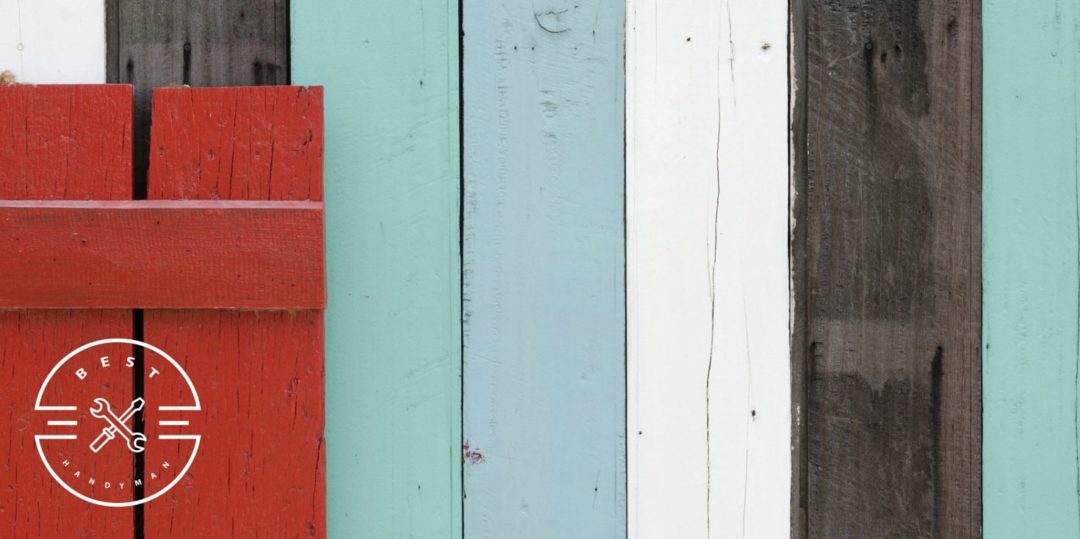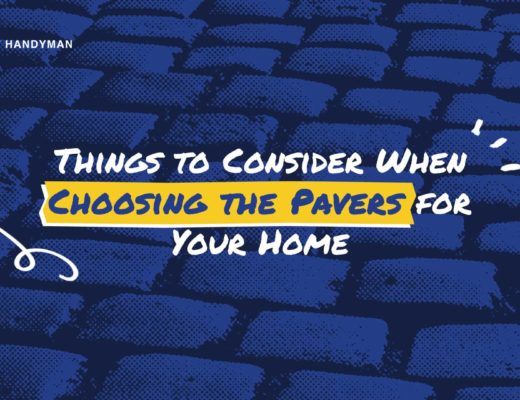Covering up outdated wood paneling may give your home a fresher, modern look. If you don’t want them removed altogether—especially because this takes so much work—but still want them out of plain sight, here are a few easy ways you can do that.
1) Cover it with wallpaper

If you don’t want to repaint or replace the wood paneling, placing wallpaper over them is the solution! It’s affordable and easy to do.
You’ll need
- Wallpaper
- Wallpaper liner
- Scissors
- Utility knife
- Smoothing tool
- Wallpaper paste
- Brush
Steps to Cover Wood Paneling with Wallpaper
- Remove the outlet cover (if there is one) on the wood paneling for a better wallpaper fit.
- Next, measure the width of the wall. Cut the wallpaper liner to the wall’s measurements, and soak the wallpaper liner in water for 45 seconds.
- Then, place the liner on the wood paneling, run the smoothing tool along it, and cut out the liner area in front of the outlet.
- Now, cut the wallpaper to be the same size as the liner.
- Apply wallpaper paste on the back of the wallpaper and place it on the walls.
- Finally, cut out its excess parts with a utility knife.
Pro tip: In case there is excess paper, press the edge of the spatula below it so it can be stably cut with a utility knife.
2) Repaint the walls

Don’t have any wallpaper to cover up the wood panels? You might want to paint it instead. Painting the panels will hide their imperfections and give them a fresh and long-lasting color.
Not only is repainting wood panels easy to do, but it’s also economical.
You’ll need
Painting Gear
- Facemask
- Coverall
- Gloves
- Shoe covers
Painting Materials
- Paint
- Primer
- Brush
- Paint roller
- Clean rug
- Masking tape
- Newspapers
- Drop cloth
- 150, 180, or 220-grit sandpaper
- Wood filler
Painting Precautions
But before you paint, it’s important to wear painting gear to protect yourself from paint spills and chemicals. These may include a facemask, coverall, gloves, and shoe covers.
Also, open the doors and windows for proper ventilation and a fast drying process.
If possible, switch on the exhaust vents as well to keep paint fumes from concentrating in the area. These fumes can contain harmful volatile organic compounds (VOCs).
Preparation
For a smooth and even finish, you can’t just paint the wood paneling directly. You have to prepare it first by doing the following:
- Put newspapers or a drop cloth on the floor to keep the paint from spilling onto or damaging the surface.
- If there are certain areas that you don’t want to paint, make a boundary along the object or wall with masking tape.
- Wipe down the panels with a clean rug to remove dust and debris. Not doing this will hinder the surface from becoming smooth and even.
What if there are cracks or holes in the wood panel?

See any cracks, holes, or other flaws on the wood panel? You need to put wood filler in them to achieve a flawless finish.
Once the filler dries, you can sand the wood panels. If the surface is smooth, use 180 or 220-grit sandpaper; for a very rough surface, 150-grit sandpaper should get the job done.
Following this, clear out the dust or loose debris using a tack cloth or a vacuum with a brush attachment.
Painting
You’re now ready to paint the wood panels. Depending on the wall size, you’ll need to use a brush or a paint roller.
- Paint the wall from top to bottom, not the other way around. Make your strokes smooth and even as much as possible.
- Allow the first coat to dry for 1 to 2 hours and apply the second coat. Note that for darker-colored panels, you may need to apply more than 2 coatings since they absorb paint faster.
3) Using a shellac primer

Alternatively, you can repair the wood panels with a shellac-based primer before painting them anew. The benefit of using it is it allows you to skip caulking and sanding.
Though expensive, shellac can block stains, hide surface flaws, and seal in smells from smoke or moisture damage. It typically also dries in less than 1 hour.
That means that you can finish the project in less time than if you use an ordinary primer.
You’ll need
Painting Gear
- Facemask
- Coverall
- Gloves
- Shoe covers
Painting Materials
- Paint
- Shellac-based primer
- Brush
- Paint roller
- Clean rug
- Masking tape
- Newspapers
- Drop cloth
- 150, 180, or 220-grit sandpaper
- Wood filler
For this, pour a primer into a paint tray, dip the paint roller in it, and smooth out the walls going from top to bottom.
Pro tip: We suggest using a microfiber roller to apply a Shellac-based primer. Due to the chemicals in the primer, it can badly damage a foam roller over time.
4) Install drywall

Installing drywall is a permanent way of covering up the wood panel. This process involves a lot of time and effort.
But one benefit of a new drywall is it will considerably prevent sound from entering or going out of the room.
You’ll need
- Pencil
- Utility knife
- Tape measure
- T-square
- Foot lift
- Drywall screws
- Drywall/keyhole saw
- Drywall panels
Steps to Install Drywall
View the clip below to know how to easily and correctly install drywall:
Step 1: Plan the job

Before doing anything, you have to plan the drywall installation.
You can do this by measuring and marking the wall and ceiling surfaces.
Then, decide whether to install the drywall panels vertically or horizontally.
Pro tip: Create as few joints as possible between the drywall panels. To do this, it’s best to hang them horizontally.
Step 2: Prepare the drywall panel

Place the light-colored side of the sheet on a drywall bench or a sturdy table.
Measure and mark where you need to cut the drywall.
Step 3: Cut the drywall sheet along the mark

Align and cut the T-square along the marked area.
Now, using a sharp utility knife, slice deep enough to cut through the face paper and part of the core.
Step 4: Snap and finish the cut on the panel

Snap the core by pressing the cut edges firmly away from you.
Finish the cutting by running the utility knife along the back paper.
Step 5: Hang the drywall panel

Hang the ceiling drywall sheet first. Fasten it to the wall frame using drywall screws. Remember to space them every 12 in.
Using a drill, drive the screwheads into the drywall, but be careful not to drive them so deep that they ruin the paper.
Step 6: Attach the drywall to the wall frame

Afterward, attach the top drywall panel to the wall framing. Make sure that it’s placed snugly against the ceiling panel.
Fasten its screws and space them 16 in. apart from each other.
Step 7: Measure and cut the bottom panel

Following this, measure and cut the lower drywall panel accurately.
Use a foot lift and ensure a half-inch gap between the floor and walls.
Leaving a 1/2 in. space from the floor will protect the panel from floods or cracks in case you opt to renovate the house in the future.
Pro tip: When installing a drywall, don’t create joints above or below the corners of windows, doors, or other openings.
Doing this will prevent cracks from forming on the finished walls.
Step 8: Mark an outline of the electrical outlet/s

If your wall has an electrical outlet, you have to create an opening for it in the drywall.
For this, measure and mark the nearest and farthest sides of the electrical outlet and mark it on the drywall.
Do the same with the top and bottom edges of the outlet and mark it on the panel as well.
Step 9: Create a cut-out of the power outlet and attach the bottom panel

Using a T-square and pencil, create a shape of the electrical outlet on the panel using the markings you’ve made.
Cut out this shape with a keyhole saw, and finally, attach the panel and fasten it with drywall screws.




